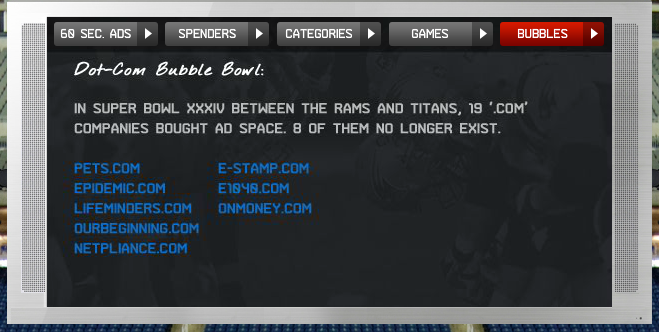Are Super Bowl Ads Too Cheap?
The following is a cross-post from our Football Freakonomics project at NFL.com.
The Super Bowl has by now become such an institution – it’s practically a second New Year’s Day – that just about everyone feels compelled to watch it, even if they don’t care one bit about football. One consequence of this fact is that the broadcast of the game (on NBC this year; it rotates annually among NBC, CBS, and Fox) has turned into another event entirely: the most massive real-time advertising opportunity in history.
This has had a few linked effects: the price of the ads has risen ever higher; advertisers spend more time and effort making better ads; and the ads have gotten so good that a lot of people time their kitchen or bathroom breaks to the game action in order to not miss the ads.
So we wanted to learn a bit more about Super Bowl ads. That’s the focus of our latest installment of Football Freakonomics. You’ll find a ton of worthwhile information in the graphic here, including a look at some advertisers who no longer exist:
The video (below) features three people who tell us what they know: Bob Parsons, CEO of GoDaddy.com, perhaps the scrappiest Super Bowl advertiser in recent memory; Darren Rovell, the excellent sports-business reporter at CNBC; and the man of the hour, Seth Winter, head of sales for NBC Sports. Winter tells us that NBC sold out the Super Bowl at a record price (an average of $3.5 million per 30-second spot) well in advance of the game, bringing NBC roughly a quarter of a billion dollars in revenue. For one football game. In a down economy.
But the most interesting theme that emerged from talking to these folks is that, as expensive as those ads are, they may be severely underpriced. Think about it. Supply is constricted (there’s only one Super Bowl – so far, at least). Demand is massive. And the price that’s set in the market – well, it really isn’t a market, at least not how we typically think of a market, with multiple sellers and buyers exchanging information over time. Selling the Super Bowl is more like an auction, except the auctioneer sets one price that applies to pretty much everyone, and you’re either in or out. To date, the seller always has enough buyers who want in, even at what the public seems to think is an outrageous price.
But what if, as Rovell suggests, the seller were to conduct a real auction, letting buyers bid against each other for each ad spot? Maybe a 30-second spot during the middle of the third quarter would fetch “only” $2 million – but the ads just before kickoff might make up for it, going for $10 million apiece!
I sincerely doubt we’ll see this happen anytime soon. Corporate culture is inherently a conservative culture. So is football, by the way. A head coach might read a research paper suggesting that it’s usually a bad idea to punt – even in your own territory — but few coaches actually have the courage to act on what the data say.
But who knows. Maybe one of the networks will take a long, hard look at the Super Bowl ad “market” and decide that they’ve been leaving hundreds of millions of dollars on the table, and try something outrageous.
Which could end up making this year’s record price of $3.5 million seem like a steal.



Comments